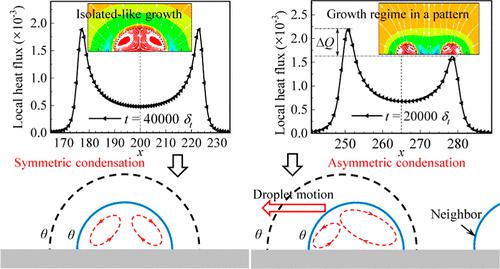Our official English website, www.x-mol.net, welcomes your feedback! (Note: you will need to create a separate account there.)
Asymmetric Condensation Characteristics during Dropwise Condensation in the Presence of Non-condensable Gas: A Lattice Boltzmann Study
Langmuir ( IF 3.9 ) Pub Date : 2022-08-02 , DOI: 10.1021/acs.langmuir.2c00496 Shao-Fei Zheng 1, 2 , Zi-Yi Wu 1, 2 , Yi-Ying Gao 1, 2 , Yan-Ru Yang 1, 2 , Xiao-Dong Wang 1, 2 , Ulrich Gross 3
Langmuir ( IF 3.9 ) Pub Date : 2022-08-02 , DOI: 10.1021/acs.langmuir.2c00496 Shao-Fei Zheng 1, 2 , Zi-Yi Wu 1, 2 , Yi-Ying Gao 1, 2 , Yan-Ru Yang 1, 2 , Xiao-Dong Wang 1, 2 , Ulrich Gross 3
Affiliation

|
In this work, the condensation characteristics of droplets considering the non-condensable gas with different interaction effects are numerically studied utilizing a multicomponent multiphase thermal lattice Boltzmann (LB) model, with a special focus on the asymmetric nature induced by the interaction effect. The results demonstrate that for isolated-like growth with negligible interactions, the condensation characteristics, that is, the concentration profile, the temperature distribution, and the flow pattern, are typically symmetric in nature. For the growth regime in a pattern, the droplet has to compete with its neighbors for catching vapor, which leads to an overlapping concentration profile (namely the interaction effect). The distribution of the condensation flux on the droplet surface is consequently modified, which contributes to the asymmetric flow pattern and temperature profile. The condensation characteristics for droplet growth in a pattern present an asymmetric nature. Significantly, the asymmetric condensation flux resulting from the interaction effect can induce droplet motion. The results further demonstrate that the interaction strongly depends on the droplet’s spatial and size distribution, including two crucial parameters, namely the inter-distance and relative size of droplets. The asymmetric condensation characteristics are consequently dependent on the difference in the interaction intensities on both sides of the droplet. Finally, we demonstrate numerically and theoretically that the evolution of the droplet radius versus time can be suitably described by a power law; the corresponding exponent is kept at a constant of 0.50 for isolated-like growth and is strongly sensitive to the interaction effect for the growth in a pattern.
中文翻译:

不凝性气体存在下滴状凝结过程中的不对称凝结特性:格子玻尔兹曼研究
在这项工作中,利用多组分多相热格子玻尔兹曼 (LB) 模型对考虑具有不同相互作用效应的不可冷凝气体的液滴的冷凝特性进行了数值研究,特别关注由相互作用效应引起的不对称性质。结果表明,对于相互作用可忽略不计的孤立样生长,冷凝特性,即浓度分布、温度分布和流动模式,通常在本质上是对称的。对于模式中的生长状态,液滴必须与其相邻的液滴竞争捕捉蒸汽,这导致浓度分布重叠(即相互作用效应)。因此修改了液滴表面上的冷凝通量分布,这有助于不对称的流动模式和温度分布。图案中液滴生长的凝结特性呈现出不对称的性质。值得注意的是,由相互作用效应产生的不对称凝结通量可以引起液滴运动。结果进一步表明,相互作用在很大程度上取决于液滴的空间和尺寸分布,包括两个关键参数,即液滴的间距和相对尺寸。因此,不对称冷凝特性取决于液滴两侧相互作用强度的差异。最后,我们在数值和理论上证明了液滴半径的演变 图案中液滴生长的凝结特性呈现出不对称的性质。值得注意的是,由相互作用效应产生的不对称凝结通量可以引起液滴运动。结果进一步表明,相互作用在很大程度上取决于液滴的空间和尺寸分布,包括两个关键参数,即液滴的间距和相对尺寸。因此,不对称冷凝特性取决于液滴两侧相互作用强度的差异。最后,我们在数值和理论上证明了液滴半径的演变 图案中液滴生长的凝结特性呈现出不对称的性质。值得注意的是,由相互作用效应产生的不对称凝结通量可以引起液滴运动。结果进一步表明,相互作用在很大程度上取决于液滴的空间和尺寸分布,包括两个关键参数,即液滴的间距和相对尺寸。因此,不对称冷凝特性取决于液滴两侧相互作用强度的差异。最后,我们在数值和理论上证明了液滴半径的演变 结果进一步表明,相互作用在很大程度上取决于液滴的空间和尺寸分布,包括两个关键参数,即液滴的间距和相对尺寸。因此,不对称冷凝特性取决于液滴两侧相互作用强度的差异。最后,我们在数值和理论上证明了液滴半径的演变 结果进一步表明,相互作用在很大程度上取决于液滴的空间和尺寸分布,包括两个关键参数,即液滴的间距和相对尺寸。因此,不对称冷凝特性取决于液滴两侧相互作用强度的差异。最后,我们在数值和理论上证明了液滴半径的演变与时间的关系可以用幂律适当地描述;对于孤立样生长,相应的指数保持在 0.50 的常数,并且对模式中生长的相互作用效应非常敏感。
更新日期:2022-08-02
中文翻译:

不凝性气体存在下滴状凝结过程中的不对称凝结特性:格子玻尔兹曼研究
在这项工作中,利用多组分多相热格子玻尔兹曼 (LB) 模型对考虑具有不同相互作用效应的不可冷凝气体的液滴的冷凝特性进行了数值研究,特别关注由相互作用效应引起的不对称性质。结果表明,对于相互作用可忽略不计的孤立样生长,冷凝特性,即浓度分布、温度分布和流动模式,通常在本质上是对称的。对于模式中的生长状态,液滴必须与其相邻的液滴竞争捕捉蒸汽,这导致浓度分布重叠(即相互作用效应)。因此修改了液滴表面上的冷凝通量分布,这有助于不对称的流动模式和温度分布。图案中液滴生长的凝结特性呈现出不对称的性质。值得注意的是,由相互作用效应产生的不对称凝结通量可以引起液滴运动。结果进一步表明,相互作用在很大程度上取决于液滴的空间和尺寸分布,包括两个关键参数,即液滴的间距和相对尺寸。因此,不对称冷凝特性取决于液滴两侧相互作用强度的差异。最后,我们在数值和理论上证明了液滴半径的演变 图案中液滴生长的凝结特性呈现出不对称的性质。值得注意的是,由相互作用效应产生的不对称凝结通量可以引起液滴运动。结果进一步表明,相互作用在很大程度上取决于液滴的空间和尺寸分布,包括两个关键参数,即液滴的间距和相对尺寸。因此,不对称冷凝特性取决于液滴两侧相互作用强度的差异。最后,我们在数值和理论上证明了液滴半径的演变 图案中液滴生长的凝结特性呈现出不对称的性质。值得注意的是,由相互作用效应产生的不对称凝结通量可以引起液滴运动。结果进一步表明,相互作用在很大程度上取决于液滴的空间和尺寸分布,包括两个关键参数,即液滴的间距和相对尺寸。因此,不对称冷凝特性取决于液滴两侧相互作用强度的差异。最后,我们在数值和理论上证明了液滴半径的演变 结果进一步表明,相互作用在很大程度上取决于液滴的空间和尺寸分布,包括两个关键参数,即液滴的间距和相对尺寸。因此,不对称冷凝特性取决于液滴两侧相互作用强度的差异。最后,我们在数值和理论上证明了液滴半径的演变 结果进一步表明,相互作用在很大程度上取决于液滴的空间和尺寸分布,包括两个关键参数,即液滴的间距和相对尺寸。因此,不对称冷凝特性取决于液滴两侧相互作用强度的差异。最后,我们在数值和理论上证明了液滴半径的演变与时间的关系可以用幂律适当地描述;对于孤立样生长,相应的指数保持在 0.50 的常数,并且对模式中生长的相互作用效应非常敏感。

























 京公网安备 11010802027423号
京公网安备 11010802027423号